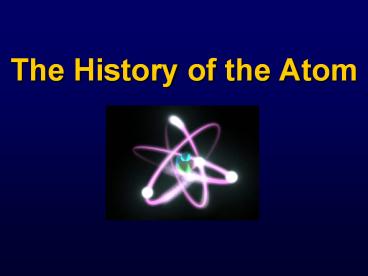The History of the Atom - PowerPoint PPT Presentation
Title:
The History of the Atom
Description:
The History of the Atom Democritus (c.460-c.370 BCE) Democritus was a philosopher in ancient Greece. He thought that all matter was made of tiny particles that could ... – PowerPoint PPT presentation
Number of Views:179
Avg rating:3.0/5.0
Title: The History of the Atom
1
The History of the Atom
2
Democritus(c.460-c.370 BCE)
- Democritus was a philosopher in ancient Greece.
- He thought that all matter was made of tiny
particles that could not be divided. - The Greek word atomos means indivisible.
3
John Dalton(1766-1844)
- Dalton was an English scientist.
- He developed modern atomic theory.
- His model of the atom is sometimes called the
billiard-ball model.
4
Daltons Billiard-Ball Model
- All matter is made of tiny particles called
atoms. - Atoms of the same element are identical.
- Atoms can combine to form compounds.
- Chemical reactions change the grouping of atoms,
but not the atoms themselves.
5
Sir J. J. Thomson(1856-1940)
- Thomson was a British physicist.
- He did experiments on cathode rays and discovered
the electron. - In 1906, he was awarded a Nobel prize for his
discovery. - His model of the atom is called the plum-pudding
model.
6
Thomsons Plum-Pudding Model
- Dalton realised that negatively charged electrons
could come from an atom. - He proposed the plum-pudding model of the atom,
suggesting that atoms consist of
negatively-charged electrons in a sea of
positive charge.
7
Ernest Rutherford(1871-1937)
- Rutherford was a chemist from Nelson, New
Zealand. - Based on the results of his gold-foil experiment,
he proposed that most of the mass of an atom is
concentrated in a central nucleus. - He won the Nobel Prize in Chemistry in 1908 for
his work.
8
Rutherfords Gold-Foil Experiment
- In his famous gold-foil experiment, Rutherford
fired alpha particles at a thin sheet of gold
foil. - He found that some particles were deflected
through large angles, and some even bounced back.
9
Rutherfords Nuclear Model
- Rutherford concluded that
- most of the mass in an atom must be in a very
small, positively-charged nucleus in the centre
of the atom - electrons spin around this central nucleus
- there was a basic unit of positive charge in the
nucleus, called the proton.
10
- Niels Bohr (1885-1962) realised that the
electrons could only occupy fixed orbits around
the nucleus.
- Louis de Broglie (1892-1987) proposed that
electrons can be regarded as waves, resulting in
an electron cloud around the nucleus. - Sir James Chadwick (1891-1974) discovered the
neutron, a nuclear particle with similar mass to
a proton but no electrical charge.
11
References
- Atom Image http//www.turbosquid.com/FullPreview/
Index.cfm/ID/197928 - Democritus http//smccd.net/accounts/goth/MainPag
es/Chron/Democritus.jpeg - Dalton http//en.wikipedia.org/wiki/John_Dalton
- Thomson http//en.wikipedia.org/wiki/J_J_Thomson
- Plum-Pudding Atom https//reich-chemistry.wikispa
ces.com/file/view/348px-Plum_pudding_atom_svg.png - Ernest Rutherford http//en.wikipedia.org/wiki/Ea
rnest_Rutherford http//nobelprize.org/nobel_prize
s/chemistry/laureates/1908/rutherford-bio.html - Gold-Foil Experiment http//wps.prenhall.com/wps/
media/objects/602/616516/Media_Assets/Chapter02/Te
xt_Images/FG02_05.JPG - Nuclear Atom http//upload.wikimedia.org/wikipedi
a/commons/thumb/e/e1/Stylised_Lithium_Atom.svg/180
px-Stylised_Lithium_Atom.svg.png - Electron Cloud http//www.csmate.colostate.edu/cl
tw/cohortpages/viney_old1/atom.jpg

